Elk Vs Moose- How To Tell, Differences, A Quick Guide


When you look at the deer family, there are a lot of similar-looking members, yet there are distinct differences in all of them; not two species are the same.
So if you feel like you are confused between two members of the family, then here we are going to discuss the differences.
Today we are going to differentiate between elk vs moose; though they might look similar sometimes, they are far from that. Today we are going to see in what ways the elk vs moose are different.
Elk vs Moose: Fascinating Facts
Before we move on to the difference, lets first take a look at some of the fascinating facts about these animals.
10 Fascinating Facts about Elks
- What’s in a Name? Elks go by different names. Biologists refer to them as Cervus Canadensis, while indigenous peoples like the Shawnee and Cree call them wapiti, which means “white rump.” This name refers to the light patch of hair on their brown bodies1.
- One Big Happy Deer Family: Elks belong to the Cervidae family, which includes white-tailed deer, pudu, caribou, and moose.
- Towering Height: Although most elks reach only 4 to 5 feet from the ground to their shoulders, their antlers can shoot up another 4 feet above their heads, making them appear like nine-foot giants.
- Loud and Proud: Elks have a distinctive high-pitched roar. Males use this vocalization to attract mates and communicate territorial boundaries. Their fundamental frequency can exceed 2 kHz, much higher than that of a human child at 0.3 kHz.
- Elk vs. Moose: Distinguishing between elk and moose? Look at their antlers. Elk antlers are long and pointed, while moose antlers are wide and flat. Additionally, elk prefer traveling in large herds, whereas moose are solitary creatures.
- Bolder in the Cold: Elks become more active when temperatures drop. You’ll spot them roaming more during fall and winter. Even in summer, they forage early mornings and late evenings to avoid the heat.
- Life Expectancy: In the wild, elks thrive for about 26.8 years. Interestingly, captivity doesn’t extend their lifespan significantly; they average around 24.7 years in zoos.
- Savvy Sprinters: Despite their weight, elks are fast runners. They can outpace horses in short sprints, reaching speeds of up to 40 mph. Their impressive agility allows them to jump as high as eight feet.
- Ancient Origins: Fossil records indicate that elk ancestors appeared 25 million years ago in Eurasia. Their population surged when the ancient ocean called Tethys vanished, giving way to vast grasslands that provided abundant food.
- Genetic Supremacy: Antlers serve as signals of genetic quality. Studies reveal that males with large antlers relative to their body size exhibit better resistance to pathogens and higher sperm production for greater reproductive capacity.
10 Fascinating Facts about Moose
- Moose vs. Elk: In Europe, moose (Alces alces) were always known as elk. However, when Europeans invaded and colonized North America, they encountered two massive deer species. They named one “elk” and kept the indigenous name “moos” for the other. Ironically, they got it the wrong way around—the moose was what they’d call elk back home. The North American elk (Cervus canadensis) was something entirely different. This confusion even led to confrontations between the crown and the colonies, with Patrick Henry famously declaring, “Give me moose, or give me death!” Ultimately, the USA became one moose nation under God1.
- Bell Under the Chin: The flap of skin under a moose’s chin is called a “bell.”
- Rubber-Nosed Swamp Donkeys: Moose are also humorously referred to as “rubber-nosed swamp donkeys.”
- Speedy Calves: Moose calves can outrun a human by the time they’re just five days old.
- Kicking Skills: A moose can kick in any direction with its front hooves.
- Antler Envy: Male moose sport impressive antlers that can grow up to six feet long during rutting season.
- Lifespan: In the wild, moose live between 15 to 25 years.
- Domestication Attempt: The Soviet Union once attempted to domesticate moose for use in their cavalry.
- Natural Predator: Believe it or not, the killer whale is a natural predator of the moose.
- Saloon Etiquette: In Fairbanks, Alaska, it is illegal for a moose to enter a saloon. Apparently, they prefer the great outdoors over a pint of ale2.
Elk Vs Moose Comparison
Both the moose and the elk are large animals inside the deer family, and both these families are incredibly fascinating and unique in their own way. The Moose has four subspecies that are recognized, and they are the largest member of the deer family.
The elk, on the other hand, has about four subspecies in Asia and about six in North America. So if you wanna know the difference between the two, then below is a table giving a quick update on the differences between the two.
Moose Vs Elk: Difference Overview
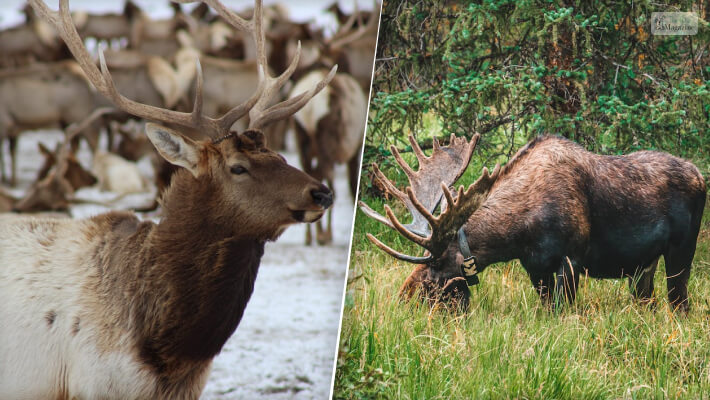
Study the table to understand in how many ways the moose and the elk are different from each other. So this might help you have a clear understanding of the difference.
| Moose | Elk | |
| Size | 5 to 7 ft, and 840 to 1550 pounds. | 4 to 5 ft, and 485 to 730 pounds. |
| Habitat | Around lakes and rivers, places with more aquatic vegetation. | Meadows, forests, and forest edges. |
| Location | North America. | East and Central Asia, Western North America |
| Nose | Rounded large nose with distinctive muzzy fatty pads on top of their nostrils. | Narrow and fairly deer-shaped nose with typical nostrils. |
| Color | Dark brown/black. | Golden brown. |
| Antlers | Flat and broad beams, open & wide shape. About 6 feet long. | Pointed and thinner, like a deer, about 4 feet tall. |
| Throat | Large Dewlap. | No Dewlap. |
| Social Structure | Solitary. | Herd Animal. |
| Behavior | Doesn’t flee fast; walks away calmly and slowly. | Quick to run away. |
| Predators | Brown bears, wolves, killer whales, Greenland sharks, Siberian tigers, mountain lions, and black bears. | Brown bears, Siberian tigers, black bears, mountain lions, wolves, and coyotes. |
| Tracks | Heart-shaped. | Tooth-shaped. |
| Lifespan | 15 to 25 years. | 10 to 13 years. |
The Main Differences Between Elk Vs Moose
In the wild, it is possible to confuse an Elk and a moose, but the keen observer can quite well understand the difference between the two, as the difference is quite visible.
Although both animals have antlers and similar-looking noses and foot pads, they most definitely have nothing in common. So let’s dive in and look at the difference between the two more clearly and properly.
Elk Vs Moose Size Comparison
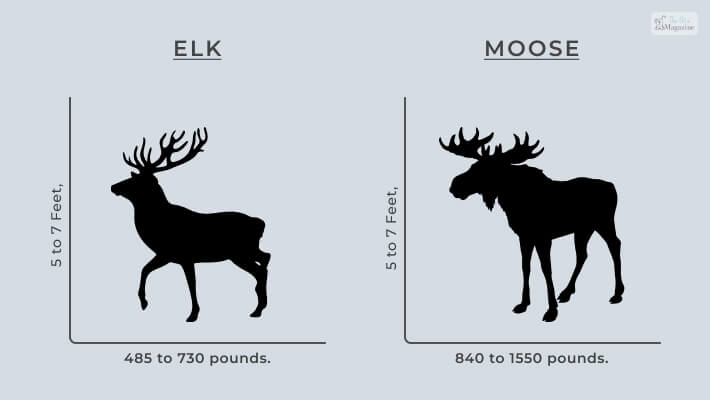
One of the biggest and clear differences between a moose vs elk is that moose is much bigger and heavier than an Elk.
While an elk is just 4 to 5 ft and 485 to 730 pounds in height and weight, a moose, on the other hand, is 5 to 7 ft and 840 to 1550 pounds in height and weight. This size difference between an elk and a moose is quite evident.
Moose Vs Elk Antlers
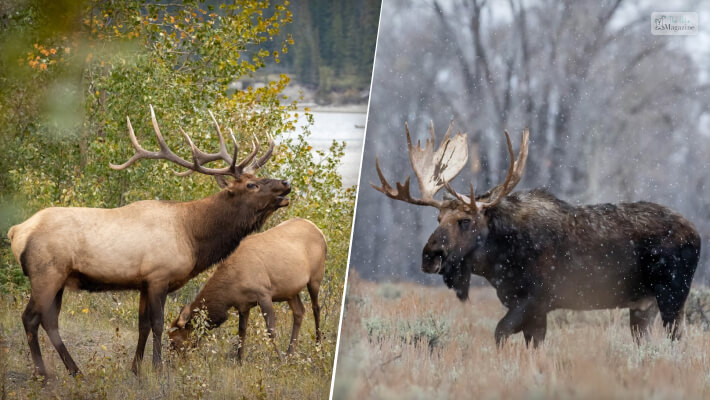
The antlers that these two deer species have are clearly very different from each other, and these antlers are an easy way to differentiate them.
On the one hand, a moose has more flat and broad beams and open & wide shapes that are about 6 feet long. And at the same time, an elk has a pointed and thinner, like a deer, that is about 4 feet tall.
Now you see that both styles and shapes of the antlers are very much different from each other. They have nothing similar to each other. Just by looking at the antlers, you can understand the differences between the two.
Elk Vs Moose Nose
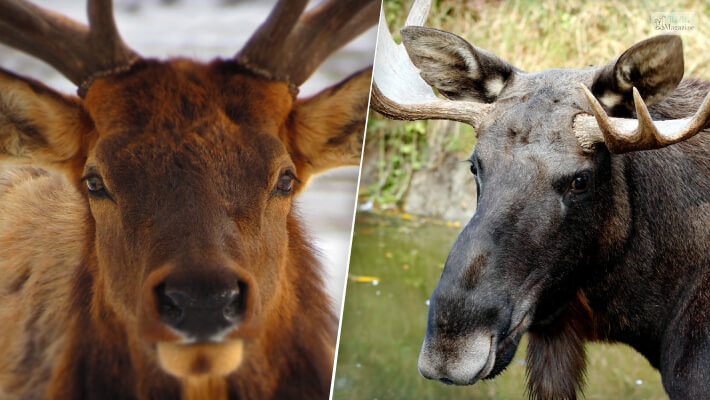
Just like any other body part, the noses of these two animals are clearly very different from each other. In the case of moose, their nose is rounded and large nose with distinctive muzzy fatty pads on top of their nostrils.
The pads are functional when they swim underwater. Moose is a great swimmer and can stay underwater for a long time while they dive down to reach aquatic plants. On the other hand, elks have a narrow and fairly deer-shaped nose with typical nostrils.
Elk Vs Moose Tracks
Another quite distinct difference between an elk and a moose is the track marks that they leave on the ground while walking. While the track mark of an elk is the shape of a tooth, and their footprint is quite light as well.
At the same time, the footprint of a moose is in the shape of a heart, and the footprints are quite heavy as well, probably because of the heavier weight of the moose. Since moose are solitary animals, they often follow these footprints when it’s mating season.
Elk Vs Moose Hunting Technique
Confusing a moose as an elk, hunters more often kill moose, even though there are no visible similarities between the two. Although the hunters have to give a rather hefty fine due to this unlawful killing of moose, amounting to $1000, and even their hunting license is revoked.
There are very few places where you can see elks and Moses together, as moose prefer places with a water body nearby, unlike elks.
And unlike elks, who run away quickly when face to face with humans, moose are rather calm and are not shy in front of humans.
Frequently Asked Questions:
Check out the most frequently asked questions related to the Elk vs Moose debate mentioned below in detail.
Eurasian Elk, which are also called European Elks, are, in reality, different names for the very same species of deer. Thus, there is technically no big difference between Euraisan elks and mooses, but of course, in terms of the size of antlers and the like, there can be certain minor differences.
Elk antlers are characterized by one primary beam that has long points to grow off of it, while the antlers of a moose are paddle-like in shape, with multiple points growing off the paddle-shaped, thick portion. Also, moose have a round, long nose as compared to the pointed, narrow nose of an elk.
All elks have this ‘rump patch’ in a light beige shade and commonly contrast darker necks as well as legs to their much lighter bodies. The body of an elk varies from season to season – from a light copper shade during the Summer months to a light tan during Spring and Winter.
Mooses are so much bigger than elks, weighing even 1800 pounds at times. These creatures can easily grow up to six feet five inches, from their shoulders to their hooves. Elks, on the other hand, can only grow up to three feet or five feet at the most.
Wrapping Up!
There you go; you can now spot the clear differences between an elk vs moose since they are not the same, even though belonging to the same deer family.
So if you think after this detailed differences between the two, you won’t get confused between the two again then give us a like and comment down below.






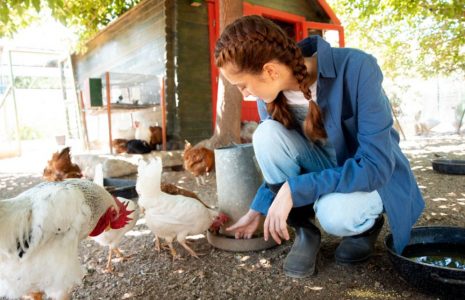

All Comments
7 April, 2024
Your article helped me a lot, is there any more related content? Thanks!
Reply